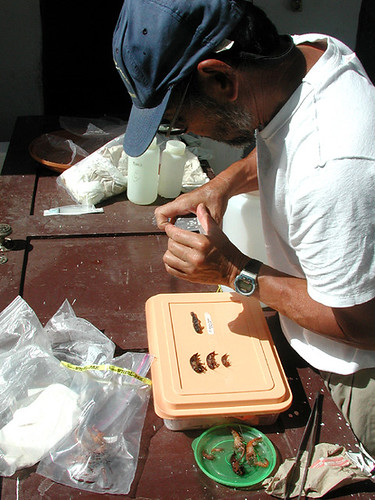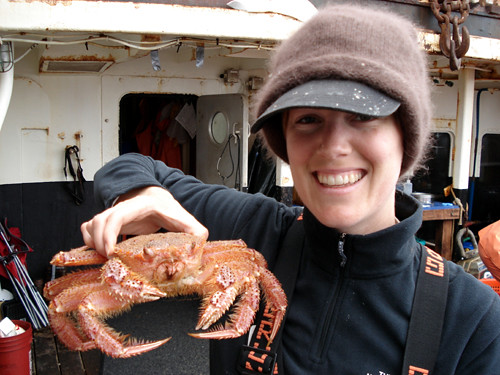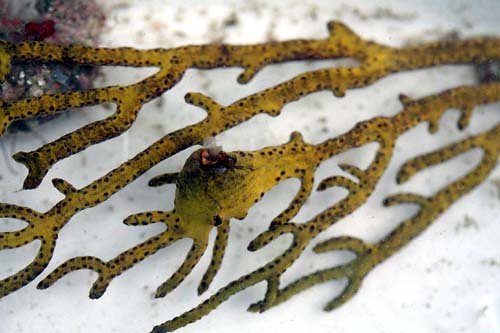I have just heard that Alex Kim, the student at Thomas Jefferson High School of Science and Technology in Virginia has received the new freshwater prawns GG III (B) collected for him and is in the process of extracting DNA from the fresh tissues. As I mentioned in the last couple of blogs, Alex is a finalist in the Intel Science Talent Search, and we are very interested in his progress. His results will add to our understanding of our own work and the biodiversity of these islands. When Alex first contacted me, I had some concern that we might have neglected to bring prawns back with us from GG I and II. We had, of course, and Alex has been studying some of the preserved specimens er brought to him in December. Just yesterday I found an image of Dr. Tomio Iwamoto carefully processing these some of these same prawn specimens in 2006 on São Tomé (during GG II). This will give you an idea of the size of the critters Alex is studying (although there are two species on the islands – I am not sure which one this is!)

Tomio Iwamoto on Sao Tome. RCD phot. GG II
The marine biologists of GG III (B) are busily sorting through their material, and I thought an early update was in order. In the last blog I mentioned that the Dr. Williams had done very well with his octocorals (also known as gorgonians or sea fans), and so had Dr. Van Syoc and Dana Carrison with their barnacles. Dana is Bob Van Syoc’s graduate student at San Francisco State University.

Dana Carrison during a more northerly field trip. NOAA photo
Bob Van Syoc found an undescribed barnacle species on São Tomé during GG II, and it appears that Dana has now confirmed this for Príncipe as well. And there may well be other new barnacle species; it is just too soon to tell. Dana is studying the relationship between these barnacles and Dr. Williams’ sea fans. This is an obligate relationship – some species of sea fans are always found in association with certain species of barnacles.

The barnacle Conopea calceola on a gorgonian. D. Carrison phot. GG III
Note that the barnacle settles on the gorgonian, and the gorgonian's tissue (red, in this case) grows up around it. Along with describing new species and adding to our island biodiversity list, Dana is testing the hypothesis that the different species of barnacles have a preference for certain species of gorgonian upon which to settle. Dana got about 30 different Príncipe barnacles but has not yet begun identifying them or comparing them to the GG II barnacles collected in São Tomé. Also included in her collections are at least three different gorgonians and their associated barnacles that were not collected previously by the Academy expeditions.

Undescribed species of Conopea on a different species of gorgonian. D. Carrison phot. GG III
New barnacle species or the relationships of freshwater prawns may not sound exciting to you. In our biodiversity race, we are studying everything we can, as biodiversity is the sum of all living species in a given area; thus, everything is important as a measure of the uniqueness and past history of these ancient islands. Think of our mushroom work: before we started, there were only four species known from São Tomé and none from Príncipe; now the people of the islands know that there are at least 220 species, many of them undescribed and unexpected. The same is true for the ant lions I have documented earlier, and I fully expect similar results when analysis of our collections of diatoms and spiders are completed. The story of biodiversity can never be told by the study of furred and feathers critters alone.
Here’s the parting shot:

Incipient Dr. Uyeda with collecting party, Nova Cuba, Principe. Weckerphoto GG III
PARTNERS
We gratefully acknowledge the support of the G. Lindsay Field Research Fund, Hagey Research Venture Fund of the California Academy of Sciences, the Société de Conservation et Développement (SCD) for logistics, ground transportation and lodging, STePUP of Sao Tome http://www.stepup.st/, Arlindo de Ceita Carvalho, Director General, and Victor Bomfim, Salvador Sousa Pontes and Danilo Bardero of the Ministry of Environment, Republic of São Tomé and Príncipe for permission to export specimens for study, and the continued support of Bastien Loloumb of Monte Pico and Faustino Oliviera, Director of the botanical garden at Bom Sucesso. Special thanks for the generosity of private individuals, George F. Breed, Gerry F. Ohrstrom, Timothy M. Muller, Mrs. W. H. V. Brooke and Mr. and Mrs. Michael Murkami for helping make these expeditions possible.